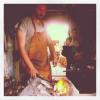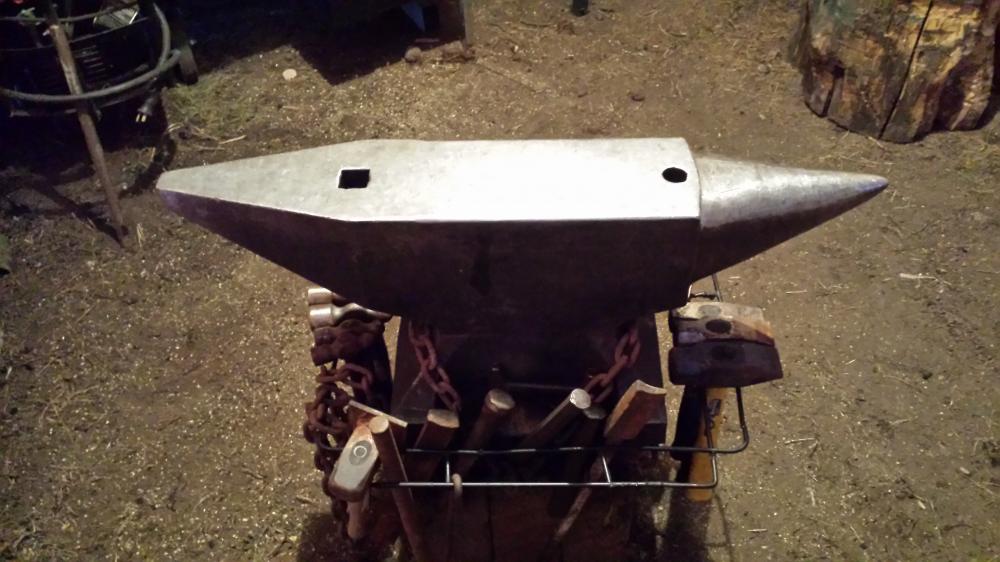-
Posts
1,299 -
Joined
-
Last visited
Content Type
Profiles
Forums
Articles
Gallery
Downloads
Events
Posts posted by Everything Mac
-
-
HI Beeser, welcome to the forum. - We like you to put your general location in your user profile as you might find some guys are quite local to you.
We don't get any forges like that here in the UK but personally if I was just starting out and that was within budget I'd go for it. As Charles said it looks as though there might be some parts missing but you could alter it to work so I wouldn't worry too much.
I think it might have been made by Buffalo. - Don't quote me on that though.
Price depends heavily on your location in the USA (assuming you're in the USA) and how easily available blacksmithing equipment is in your area.
All the best
Andy
-
Cheers buddy!
 She's a beast.
She's a beast.
All the best
Andy
-
I'd say Peter Wright too. You'll need to clean all that paint off. Paint stripper and a wire wheel on an angle grinder will do it.
The rebound is probably being reduced by the paint imo.
Andy
-
Merry Christmas folks! Have a good one!

All the best
Andy
-
I'm no expert but I'd have thought the tube itself would not get "that" hot?
Enjoying the build so far. It's nice to see threads like this from time to time. Be sure to keep us updated.

All the best
Andy
-
I've got a couple. An aluminium fire extinguisher with the top cut off I use for oil and quenching longer blades. (Rare these days) - a small Galv mop bucket with the mop bit cut out is my main quench bucket and I have a large blue water barrel that gets used from time to time as well. It's a bit too big really and can get in the way but it's handy from time to time.
Best one's I've seen are the stainless/ aluminium beer kegs with the tops cut off.
Andy
-
On 22 December 2015 at 5:16 AM, Dayne said:
I picked this up in cranbrook last September 2014.
Sahinler 150kg. The man I got it from helped me with it into my truck. Then it went to my friend's farm where he was kind enough to help lift it by hand. I had a tarped up horseshelter as a forge for a while. Then I bought a house with a garage and made a new stand. I used a 5 to 1 to lift the anvil by myself. I tried uploading a video of the process but something tells me it's too big.
That's an unusual one Dayne, the hardy hole is usually the nearest the round horn. Would you be kind enough to post a close up picture of the manufacturers stamp please.
All the best
Andy
-
My dies are mild steel as well, no complaints so far.
Andy
-
Hey Alan I'd love a bit of it if I may. I'll drop you a pm.
All the best
Andy
-
I agree with Ian. Whilst you are correct Dan, it might not have been marketed as a pig anvil they have certainly been nicknamed as such.
Andy
-
https://www.youtube.com/watch?v=j151gfJMWAc - stupid one line posting bug. When will this be fixed?? This video should be helpful. Cheers
-
Hi dfsrusa, welcome to the site.
Delaminating is where layers of a material (laminations) come away from each other. Imagine a stack of wooden boards sitting on top of each other. If you were to hit that with a hammer the energy wouldn't travel very effectively through them and the loose boards would be likely to separate and peel away from each other. This is delamination.
Stacking the steel flat on top of each other, even welding it together at the sides doesn't produce a strong block. Like the wood it won't transfer energy very well and will likely split over time.
Stacking the steel vertically means energy can travel down through its length making for a better tool. Imagine a cardboard tube, lying horizontally it wouldn't take much to flatten it, but flip it up vertically it is much stronger.
Cheers
Andy
-
Hey Vaporlock that's one unusual anvil you have there. - Out of interest are all the hardy holes the same size? There can't be very many of those anvils left in the world that's for sure.
I have no idea what it's use might have been sadly. Though for some reason I do suspect it was for making cutlery of some sort.
Are there any makers marks?
All the best
Andy
-
Cool. I'm sure it will look decent when it's finished. Are you putting an upsetting block on there?
Cheers
-
Quite an ambitious project there Paul. Looks good to me so far.
What is the weight of the block you have at the end of the first video?
Cheers
Andy
-
As interesting as this thread has been, would any of the big boys care to tell me how it is an "Anvil review by brand"?
Cheers
Andy
-
2 hours ago, Metalmark said:
That's awsome Andy
Thank you
Mark
No problem Mark. I'm sorry I can't tell you anything about the maker but I think those logo's are close enough to assume it's the same one.
Either way it looks like you've got a great anvil.
All the best
Andy
-
Spotted this earlier today and was reminded of your anvil.

Looks like HPW in the circle. Your's is rather worn but the profiles match.
Cheers
Andy
-
What's the measurement from the cut outs to the centre of the tue Kubiack? Is it too high?
I'll get cracking with this project when I get home in a couple of weeks.
Andy
-
Cheers Joel - I must admit I did wonder about that. I'm sure there's some maths involved in there somewhere but I assume there is a sweet spot. In the plan linked above Mark used 5" pipe. I was going to use some 3" pipe I had but then found this old steel extinguisher bottle which is 5". I figured more water wouldn't hurt. I also happen to have a thick donut of steel with a 1" hole running through it which would be ideal for the end cap.
How are you finding your tue Joel? Any issues with the lack of taper?
Andy
-
Out of interest, what thickness is the pipe you've used for the outer part of the tue? I have picked up a 5" Dia by 1/8" fire extinguisher I had intended on using as I have struggled to find any pipe in a suitable diameter with a thick wall.
Cheers
-
Nice one. Great forge you have there. Thanks for posting pictures.
Andy
-
On 12/12/2015, 3:03:24, Joel OF said:
I hate myself for asking such an abstract, loose question, but it's something that's been niggling at the back of my mind for a while...I apologize in advance.
What does the word "traditional" mean to you in relation to ironwork? I don't really know what the word means to me. Is it a point in history? When does "traditional" become "modern"?
I'm forever reading on other smiths' websites "I use traditional and modern methods". I don't think anyone would dispute that punching a hole is a traditional method, but is drilling traditional?
I think everyone would agree that a fish tail scroll growing in size according the to Fibonacci sequene is traditional, but what about the fluid, elongated curves of an Art Nouveua scroll, are they traditional? Are they only traditional to the Art Nouveau style, or has Art Nouveau been around long enouh for those types of scrolls to be accepted as generically traditional?
At what point in time will MIG welding superecede forge welding as the traditional type of welds in architectural ironwork? I suppose at the centre of my questiion is - how long does something have to be around or be the norm before it becomes traditional?
I think Timothy Miller hit the nail on the head in his post.
I concur with much of what has been said. To me "Traditional" means using methods that pre-date electricity rather than what is produced. I guess it could be considered a demonstration of ones skill, i.e. you can use techniques that are far harder than using currently available technology. 3D printing for example. You could design an item to be printed on a 3D printer but beyond some computer savvy there is little perceptible skill involved.
With regards to your second question I would say 1-200 years. I have nothing to really base that on other than my perception, which I think is really what is important here. Mine, yours, the customers perception of tradition is what matters. - The idea of the "Blacksmith" is rather a romantic one for many people I think, hunched over a fire in a dark forge conjuring up dark ancient powers to shape and form a material that cannot under normal circumstances be bent to the will of anyone.
The reality of course as we all know is remarkably different most of the time. We have access to machines and tools that make the work faster, easier, more productive. As Frosty says, if the customer wants to pay for it I'd gladly forge semi naked with them watching. But I won't let the perceived idea of tradition get in the way of using an angle grinder and a mig welder if I don't have to.
Andy
-
That's the idea Francis. I was getting frustrated with the number of beginners on here particularly that are struggling to find ideas for their first projects. It's not aimed at intermediate level smiths or the pro's obviously.
The next video will be covering a few more techniques.
Cheers




Building an Industrial Swage Block
in Swage Blocks
Posted
What was the final cost all in then JR? It looks lovely but going by the numbers on the first post that was one xxxx of an investment...
Andy